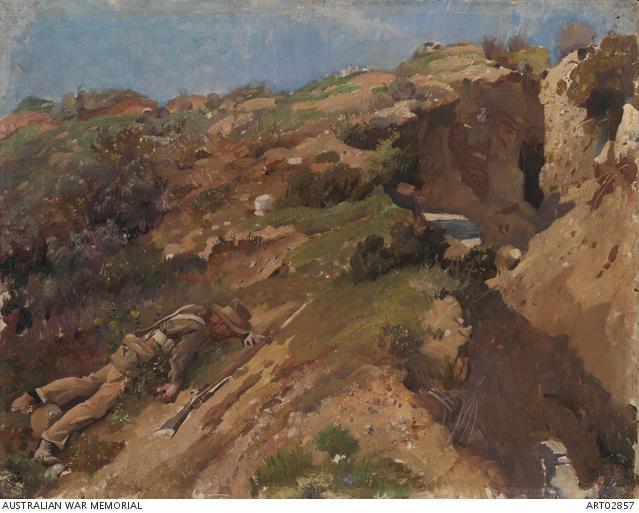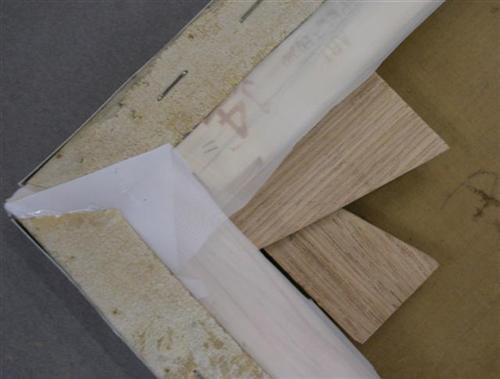Study for Dead Trooper

The majority of conservation treatments on paintings in the George Lambert: Gallipoli & Palestine Landscapes exhibition were relatiavely straightforward. There were a few exceptions to this rule, one being Study for Dead Trooper and detail of Turkish trench, Gallipoli (pro Patria), oil on canvas, 1918. A lot of work was required on the painting and its frame. This included: cleaning the surfaces of the painting and its frame, filling and inpainting the frame, cleaning the canvas edges, strip lining the whole work, attaching the canvas to a new stretcher, flattening some areas of the canvas as well as filling and inpainting the paint layer. The frame had a number of specific issues. The task of removing the old layer of gold coating from the frame was more difficult than usual as there were many layers of gesso between the bronze leaf and the top gold coating that had to be removed. There were also problems with previous repairs to the frame that were falling off during the cleaning process. As the repairs to process the frame’s corners progressed much of the old fill broke away, loosening sections that were previously fixed down. Subsequently, many parts of the corner mouldings had to be re-placed into position and sometimes new sections were moulded to size and shape. Inpainting of the filled areas and all the losses on the bronze leaf original base layer also required hours of work. Difficulty arose as there were many small areas, each of varying tones of gold. It was also one of the larger frames to be included in the exhibition so there was a greater surface area to deal with than the others.This oil on canvas painting was originally stretched onto a stretcher but at some point the canvas was laid onto a wood panel. Possibly this was to make it easier to fit into the frame and there are several examples in the collection of this having been done.

Work on the canvas began by firstly carefully removing it from the wood panel support. The canvas was not adhered very well to the panel so removal was reasonably straightforward. The back of the canvas had a great amount of old adhesive around the edges. This adhesive had to be removed to have the cleanest possible surface for further treatment. Once the old adhesive was removed the edges were slightly dampened and flattened with a heated spatula. The flatness allowed easier manipulation for the procedure of adhering polyester strips. Each strip was adhered to the canvas edge with BEVA® 371 film under heat. These polyester strips became extensions of the canvas and allowed for a greater surface area to staple the canvas to the new stretcher bar. The addition of these strips also gave the weakened canvas edges much needed extra strength. Each edge was carefully aligned and stapled onto a new stretcher. The sides of the canvas were protected by thin strips of card for added protection from the frame rebate. The tension in the canvas was then adjusted by the 'keys' in the corners of the stretcher. The next task was flattening four bulges in the canvas. These areas were left under a poultice and flattened with weights. Consolidation of two areas of flaking paint was undertaken using an adhesive combined with heat to attach the fragile areas. The final process was glazing, rehousing and putting a protective backing on the painting. A laminated glass was placed into the rebate edges, the painting slotted in and a backing board sat behind the canvas. The backing board was fixed down with several brackets and hangers were nailed into the frame. Laminated, non-reflective glass was used to provide better viewing and strength as the painting will be travelling as part of the exhibition.